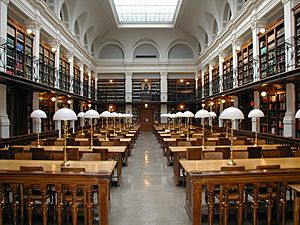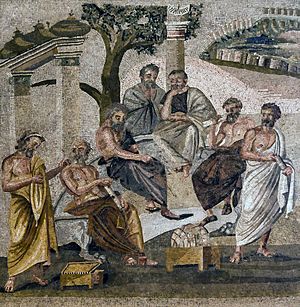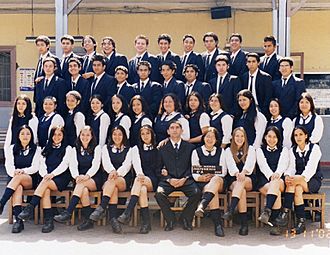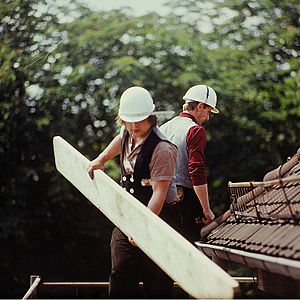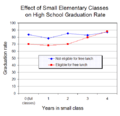Education facts for kids
Education is all about teaching and learning skills and knowledge. It helps people learn how to do things and encourages them to think about what they discover. Education also teaches how to find and use information.
Through education, the knowledge of a society, country, and the world is passed down from one generation to the next. In democracies, education helps children and adults learn how to be active and helpful citizens.
Education can guide individuals to improve their lives. People, societies, and countries that are well-educated often have an advantage in growth and development.
There are different ways to think about types of education. One common way is to divide it into formal education, non-formal education, and informal education.
Formal education usually happens in a school. Here, a person can learn basic subjects, academic skills, or skills for a specific job. Young children might go to a nursery or kindergarten. Formal education often starts in elementary school and continues through secondary school. After that, higher education is usually at a college or university, where you can earn an academic degree.
Non-formal education includes things like adult basic education or learning to read and write if you didn't go to school. In non-formal education, someone who is not in school can learn basic skills or job skills. Home education, individualized instruction (like learning at your own pace), distance learning, and computer-assisted instruction are other examples.
Informal education is when you learn without a specific plan or school. For example, a parent teaching a child how to prepare a meal or ride a bicycle is informal education. People can also learn informally by reading many books from a library or by using educational websites. It's learning that happens naturally in daily life.
Many public schools offer free education, paid for by the government. Parents can also choose to send their children to private schools, but they have to pay for these. In some poorer places, some children cannot go to school. This might be because their countries don't have enough schools, their families don't have enough money, the children have to work for money, or because of negative prejudice against education for girls.
There are primary schools and secondary schools. In many places, these are funded by the government. Colleges and universities usually charge Tuition payments (fees), which can be very different in various countries.
Contents
History of Education
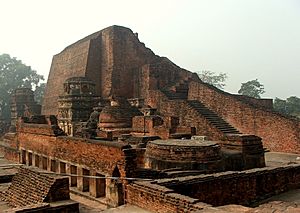
Education started a very long time ago, even before written history. Adults would teach young people the knowledge and skills they needed for their society. In societies without writing, this was done by talking and showing. Story-telling helped pass on knowledge, values, and skills from one generation to the next.
As cultures grew and needed more complex knowledge, formal education began. Schools existed in Egypt during the time of the Middle Kingdom.
Plato started the Academy in Athens, Greece. This was the first place for higher learning in Europe. Later, the city of Alexandria in Egypt became a major center for learning, with the famous Library of Alexandria built in the 3rd century BCE.
In China, Confucius (551–479 BCE) was a very important philosopher. His ideas about education still influence China and nearby countries like Korea, Japan, and Vietnam. Confucius taught many students, and his ideas were written down in a book called the Analects.
After the Roman Empire fell in 476 CE, the Catholic Church helped keep learning alive in Western Europe. The church set up cathedral schools in the Early Middle Ages. Some of these schools later became medieval universities, which are the ancestors of many modern European universities. The University of Bologne, founded in 1088, is considered the first and oldest continuously running university.
During the Middle Ages, Islamic science and mathematics also grew greatly under the Islamic caliphate.
The Renaissance in Europe brought new scientific and intellectual discoveries. Around 1450, Johannes Gutenberg invented the printing press, which made it possible for books and ideas to spread much faster. European ideas about education, philosophy, religion, arts, and sciences then spread around the world. Scholars also brought new ideas back from other civilizations. For example, Jesuit China missions helped share knowledge between China and Europe, translating books like Euclid's Elements for Chinese scholars and the ideas of Confucius for Europeans. The Enlightenment in Europe led to a more non-religious view of education.
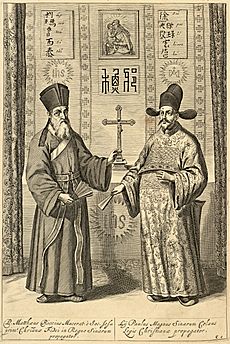
Today, in most countries, full-time education is required for all children up to a certain age, whether at school or at home. Because of this, and because the world's population is growing, UNESCO believes that in the next 30 years, more people will receive formal education than in all of human history before now!
Formal Education Types
Formal education happens in a structured place where the main goal is to teach students. This usually takes place in a school with classrooms of many students learning together with a trained teacher. Most school systems are designed around certain values that guide choices about what is taught, how schools are organized, how classrooms look, how students and teachers interact, how students are tested, and how many students are in a class.
Preschool Education

Preschools offer education for children from about three to seven years old, depending on when they start primary education in their country. These are also called nursery schools or kindergarten. Kindergarten programs focus on helping children develop physically, mentally, and morally in a balanced way.
Primary Education
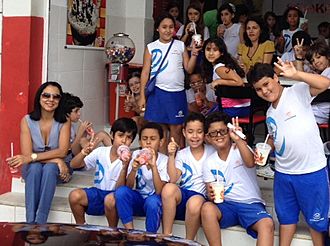
Primary (or elementary) education is the first five to seven years of formal schooling. Generally, it lasts six to eight years and starts when children are five or six. Around the world, about 89% of children aged six to twelve are in primary education, and this number is increasing. Many countries have promised to make primary education available to everyone by 2015, and in many places, it is required by law.
The change from primary to secondary education usually happens around age eleven or twelve. Some education systems have separate middle schools, where students move to the final stage of secondary education around age fourteen. Schools that provide primary education are usually called primary schools or elementary schools.
For example, in India, education is required for twelve years, with eight years of elementary education (five years of primary and three years of upper primary).
Secondary Education

In most modern education systems, secondary education is the formal schooling that happens during the teenage years. It's the step between required primary education for younger students and optional higher education (like university or vocational school) for adults.
Depending on the country, schools for this age group might be called secondary schools, high schools, gymnasiums, lyceums, middle schools, colleges, or vocational schools. The exact age range varies, but it's generally from around the seventh to the tenth year of schooling.
In the United States, Canada, and Australia, primary and secondary education together are sometimes called K-12 education. The goal of secondary education can be to give students general knowledge, prepare them for higher education, or train them directly for a profession.
Secondary education became more common in the United States around 1910. This was because large companies and new technology needed more skilled workers. So, high schools were created with classes focused on practical job skills. This helped both employers (who got skilled workers) and employees (who earned higher wages).
In Europe, secondary education has a longer history, with grammar schools and academies existing since the 16th century.
Community colleges offer another choice at this stage. They provide college-level courses to people living in a specific area, often without requiring them to live on campus.
Tertiary (Higher) Education
Higher education, also called tertiary or postsecondary education, is the optional level of schooling after high school or secondary school. This includes undergraduate and postgraduate education, as well as vocational training.
Colleges and universities are the main places for tertiary education. People who finish higher education usually receive certificates, diplomas, or academic degrees.
In many developed countries, a large number of people (up to 50%) now go on to higher education at some point. This makes higher education very important for a country's economy, both as an industry itself and as a source of trained and educated people for other jobs.
University education involves teaching, research, and community service. It includes both undergraduate (first degree) and graduate (advanced degree) levels. Universities are often made up of several colleges. Many career-specific courses are now available to students through the Internet.
One type of university education is a liberal arts education. This kind of education aims to give broad general knowledge and develop thinking skills, rather than focusing on just one job skill.
Vocational Education
Vocational education focuses on direct, hands-on training for a specific job or skill. This can happen through an apprenticeship (learning from a skilled worker) or internship (working in a field to gain experience). Institutions also teach vocational courses like carpentry, agriculture, engineering, medicine, architecture, and the arts.
Special Education
In the past, children with disabilities often couldn't get a public education. However, early doctors and educators like Itard and Gallaudet helped start special education. They focused on teaching students individually and helping them learn practical skills. In its early days, special education was mainly for people with severe disabilities, but now it helps anyone who has difficulty learning.
Other Ways to Learn
Alternative Education
While called "alternative" today, many of these systems have been around for a long time. After public schools became common in the 1800s, some parents looked for different ways to educate their children. Alternative education grew as a response to what some saw as problems with traditional schooling.
Many different approaches appeared, including alternative schools, self-learning, homeschooling, and unschooling. Examples of alternative schools include Montessori schools, Waldorf schools, and Summerhill School. Charter schools are another type of alternative education that have become more common in the US.
Sometimes, ideas from these alternative methods become part of regular education. For instance, Friedrich Fröbel's ideas for early childhood education in 19th-century Germany are now used in modern kindergarten classrooms.
Indigenous Education
Indigenous education means including the knowledge, ways of learning, and content from native cultures in formal and non-formal education. After a time of colonialism, using indigenous education methods can help native communities get back and value their languages and cultures. This can also help indigenous students do better in school.
Informal Learning
Informal learning is one of the ways people learn, as defined by the Organisation for Economic Co-operation and Development (OECD). It happens in many places, like at home, at work, and through daily interactions with others. For many people, this includes learning a language, cultural norms, and manners. For young people, informal learning is an ongoing process that also happens outside of school, in youth programs at community centres and media labs.
Informal learning usually takes place outside of schools. It doesn't follow a set plan and can happen by chance, or when you need to solve a problem. It's not always planned to be a "lesson" but is often unconscious and related to managing daily life. It's experienced directly in its natural way of everyday life and is often spontaneous.
The idea of 'education through recreation' was used for children's development in the 1800s. Later, it included young adults, focusing on physical activities. The idea is that you can learn without realizing it, through all of life's activities.
Open Education and Electronic Technology
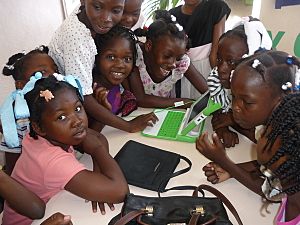
In 2012, the use of electronic educational technology (also called e-learning or online learning) grew much faster than traditional learning. Open education is quickly becoming a very popular way to learn because it can be very effective.
The cost of education has always been an issue. Online courses can sometimes be more expensive than in-person classes. However, many large universities like Harvard, MIT, and Berkeley are now offering free or very cheap full courses through platforms like edX. Other universities also offer open education. This has been called the biggest change in how we learn since the printing press.
Even though studies show online learning can be effective, many people still prefer traditional campus education for social and cultural reasons.
Currently, it's less common to get a traditional degree through open education compared to campus universities. However, some open universities do offer regular degrees, like the Open University in the United Kingdom. Many open education sources offer their own certificates, which are gaining more respect. Many open universities are working to offer standardized tests and traditional degrees.
A community is starting to form around distance learning, with students creating study groups and meetups to connect, similar to traditional campuses.
Why Education Matters (Economics)

Many people believe that high levels of education are vital for countries to have strong economic growth. Studies often show that poorer countries can grow faster than rich ones because they can use new technologies already developed by richer countries. However, using new technology requires knowledgeable managers and engineers. So, a country's ability to learn from others depends on its educated people, also known as "human capital".
For individuals, there's a lot of research showing how much money people earn is linked to their schooling and other skills. This research has led to many studies, but it's also debated. One challenge is that some smart students might not reach their full academic potential because of money problems.
Economists Samuel Bowles and Herbert Gintis argued in 1976 that in American schooling, there was a conflict between the goal of everyone participating equally in a democracy and the unfairness caused by capitalism.
The Future of Education
Many countries are changing how they educate their citizens. The world is changing very quickly, which means that a lot of knowledge becomes old or wrong faster than before. So, the focus is shifting to teaching how to learn: how to pick up new knowledge quickly and adapt easily. For example, Finnish schools have started to move away from regular subject-based lessons. Instead, they are trying "phenomenon-based learning," where students study big topics like climate change.
Education is also becoming something that isn't just for children. Adults need to keep learning throughout their lives too. Some groups, like the Finnish Innovation Fund Sitra, have even suggested that lifelong education should be required.
Images for kids
-
A high-school senior (twelfth grade) classroom in Calhan, Colorado, United States
-
Universities often host prominent guest speakers for student audiences, e.g. First Lady of the United States Michelle Obama delivering remarks at Peking University, Beijing, China
-
A volunteer reads aloud to children in Laos.
-
Beijing Normal University, which is governed directly by the Chinese Ministry of Education, is an example of collaboration between different entities in the education sector.
-
Historical Madrasah in Baku, Azerbaijan.
-
A class size experiment in the United States found that attending small classes for three or more years in the early grades increased high school graduation rates of students from low income families.
-
Knowledge Day in Donetsk, Ukraine, 2013.
-
John Locke's work Some Thoughts Concerning Education was written in 1693 and still reflects traditional education priorities in the Western world.
See also
 In Spanish: Educación para niños
In Spanish: Educación para niños


